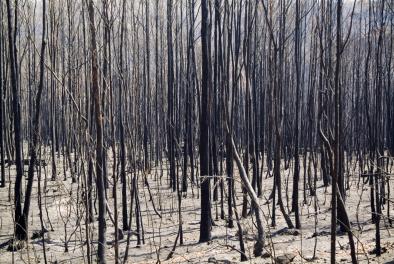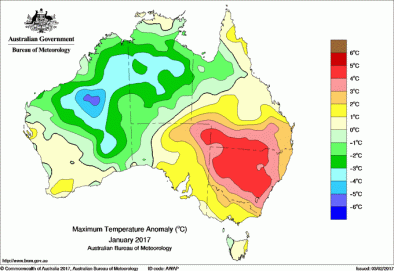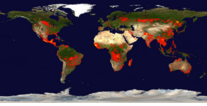Australia Bushfire Season 2015 - 2016
During the Australian summer of 2015/16, the country experienced a bushfire season with high numbers of fires: the southwest and southeast of the country were most affected with about 250,000 acres of vegetation burned in Tasmania.[1]
Heat waves and bushfires are common during Australia’s hot summer months, but climate change is worsening the underlying conditions that fuel the most extreme heat and wildfire events. A study looking at Australia's 2015/16 bushfire season found that climate change doubled the risk of extreme surface dryness.[1]





Climate change is leading to hotter, drier conditions in Australia
Consecutive years of record-breaking and extreme bushfires may be the beginning of a new normal for Australia when it comes to bushfire season. In January 2013, Australia’s Bureau of Meteorology had to add a new color[1] to the top of its temperature forecast scale. In January 2014, extreme heat led officials to suspend the 2014 Australian Open[2] tennis tournament.
Extreme heat and dry spells have become more common and severe over the past few decades. Since 1950 the annual number of record hot days across Australia has more than doubled and temperatures have warmed by almost 1°C.[3] Eight of Australia’s 10 warmest years[4] have occurred since 2002. In recent years, 2015 was the fifth-hottest on record, 2014 the third hottest, and 2013 the hottest on record. Longer, hotter and more intense heatwaves, and more frequent and severe droughts, are driving up the likelihood of very high bushfire risk, particularly in the southwest and southeast of Australia.[5]
Karl Braganza,[6] manager of the BoM’s climate monitoring section, said the warming trend fueled by the release of greenhouse gases from human activity, was “very clear.” According to Braganza, “It’s getting hotter but also there are longer durations of heat. There are larger areas of the continent getting covered by this heat, which is a salient point when you are working out bushfire conditions.” Will Steffen,[7] an adjunct professor at the Australian National University’s Fenner School of Environment and Society, similarly finds that climate change is making fires more severe, with the southeastern part of the country more vulnerable than before. “We are seeing an increase in the most populated areas of Australia. That’s really of concern, the fires that can encroach on the edge of cities.”
Climate change has worsened extreme events like the annual bushfire season
Southern Australia stands out as being at increased risk from extreme weather events connected to climate change, including heatwaves, drought and bushfires. Over the last 40 years much of eastern, southern and southwestern Australia has become drier, and there has been an increase in both the duration and frequency of heatwaves.[8] The Big Dry of 1997–2009 in Victoria was the driest period on record in the state,[9] surpassing previous droughts that extended from 1936-1945 and 1896–1905. Scientists say the record drought is due in part to the expansion of the Hadley Cell—the atmospheric regions on both sides of the equator that circulates warm tropical air poleward—which is known climate change signal.[10] In the last two decades, Victoria has experienced both a 10-20 percent reduction in rainfall during the late autumn/winter season and a reduced frequency of very wet years.
Sarah Perkins,[11] a research fellow at the University of New South Wales’ Climate Change Research Centre, has pointed to Australia’s prolonged and extreme heat waves in 2014 saying, “These warm conditions, particularly in spring, contributed to yet another early start to our bushfire season, and recent heat wave events have also contributed to heightened bushfire risk and poor firefighting conditions currently in South Australia.” According to Perkins, "The fact that we are experiencing such record-breaking and extreme conditions, both during consecutive years and since the turn of the millennium, is a clear sign that climate change is happening now, and here, in Australia."
The trend toward more frequent and more severe heat waves and bushfires in Australia is part of a larger global trend
The number, duration and intensity of heat waves (although highly variable over a small number of years) should not change over decades in a stable climate. The increasing severity of Australian heat waves are part of a long-term global trend towards more heat waves and hot weather in many regions, a trend that is very likely influenced by human-driven climate change.[12] Extreme and unprecedented heatwaves have occurred in recent years worldwide, including Europe in 2003, Russia in 2010 and several regions in the south and central US in 2011 and 2012. Among developed countries, however, “Australia is expected to be one of the first and worst impacted,” says Victoria McKenzie-McHarg,[7] climate change program manager at the Australian Conservation Foundation, “because we have such an extreme climate very vulnerable to changes in temperature.”
Related Content










